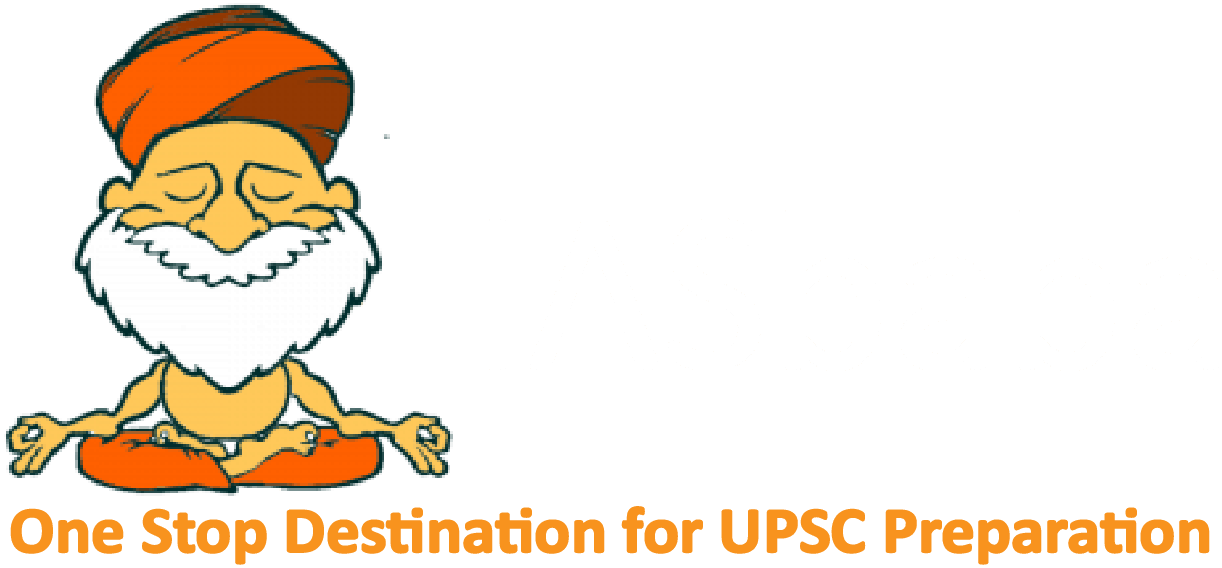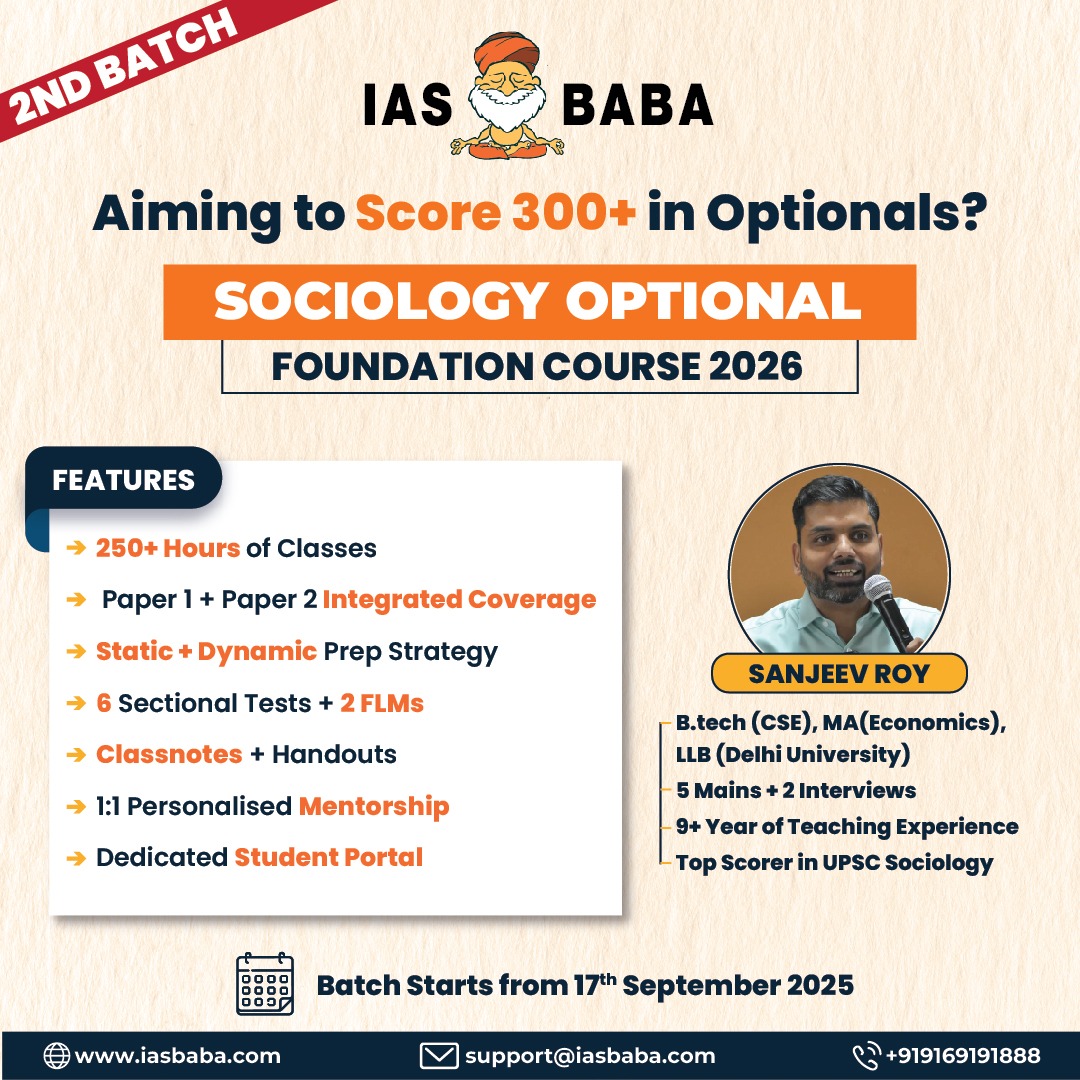IASbaba Daily Prelims Quiz
For Previous Daily Quiz (ARCHIVES) – CLICK HERE
The Current Affairs questions are based on sources like ‘The Hindu’, ‘Indian Express’ and ‘PIB’, which are very important sources for UPSC Prelims Exam. The questions are focused on both the concepts and facts. The topics covered here are generally different from what is being covered under ‘Daily Current Affairs/Daily News Analysis (DNA) and Daily Static Quiz’ to avoid duplication. The questions would be published from Monday to Saturday before 2 PM. One should not spend more than 10 minutes on this initiative.
Gear up and Make the Best Use of this initiative.
Do remember that, “the difference between Ordinary and EXTRA-Ordinary is PRACTICE!!”
Important Note:
- Don’t forget to post your marks in the comment section. Also, let us know if you enjoyed today’s test 🙂
- After completing the 5 questions, click on ‘View Questions’ to check your score, time taken, and solutions.
Test-summary
0 of 5 questions completed
Questions:
- 1
- 2
- 3
- 4
- 5
Information
To view Solutions, follow these instructions:
- Click on – ‘Start Test’ button
- Solve Questions
- Click on ‘Test Summary’ button
- Click on ‘Finish Test’ button
- Now click on ‘View Questions’ button – here you will see solutions and links.
You have already completed the test before. Hence you can not start it again.
Test is loading...
You must sign in or sign up to start the test.
You have to finish following test, to start this test:
Results
0 of 5 questions answered correctly
Your time:
Time has elapsed
You have scored 0 points out of 0 points, (0)
| Average score |
|
| Your score |
|
Categories
- Not categorized 0%
| Pos. | Name | Entered on | Points | Result |
|---|---|---|---|---|
| Table is loading | ||||
| No data available | ||||
- 1
- 2
- 3
- 4
- 5
- Answered
- Review
-
Question 1 of 5
1. Question
-
With reference to cheetah conservation, consider the following statements:
-
The Asiatic cheetah is morphologically smaller and slimmer than the African cheetah, with a paler coat and more prominent belly fur.
-
Both Asiatic and African cheetahs are currently found in wild populations across India and Africa.
-
While the Asiatic cheetah is listed as Critically Endangered, the African cheetah is listed as Vulnerable in the IUCN Red List.
How many of the above statements are correct?
Correct
-
-
Solution: (b)
Explanation:
- Statement 1: Asiatic cheetahs are smaller, slimmer, paler, with more belly fur. Hence this statement is Correct
- Statement 2: Asiatic cheetahs are extinct in India; survive only in Iran. African cheetahs are found in sub-Saharan Africa. Hence this statement is Incorrect
Statement 3: IUCN status – Asiatic cheetah (Critically Endangered), African cheetah (Vulnerable). Hence this statement is Correct
-
Incorrect
-
-
Solution: (b)
Explanation:
- Statement 1: Asiatic cheetahs are smaller, slimmer, paler, with more belly fur. Hence this statement is Correct
- Statement 2: Asiatic cheetahs are extinct in India; survive only in Iran. African cheetahs are found in sub-Saharan Africa. Hence this statement is Incorrect
Statement 3: IUCN status – Asiatic cheetah (Critically Endangered), African cheetah (Vulnerable). Hence this statement is Correct
-
-
-
Question 2 of 5
2. Question
-
Consider the following statements regarding constitutional provisions for the development of Hindi:
-
Article 351 of the Constitution directs the Union to promote the spread of Hindi and develop it as a medium of expression for all elements of India’s composite culture.
-
Article 343 declares Hindi in the Devanagari script as the official language of the Union.
Which of the above statements is/are correct?
Correct
-
Solution: (c)
Explanation:
- Statement 1: Article 351 directs the Union to promote Hindi so it may serve as a link language for India’s composite culture. Hence this statement is Correct
- Statement 2: Article 343 declares Hindi (Devanagari script, with international numerals) as the Union’s official language. Hence this statement is Correct
Official Languages Act, 1963:
- Background:
- Article 343 of the Constitution made Hindi in Devanagari script the official language of the Union.
- English was to continue for 15 years (till 1965) as an associate official language.
- Widespread protests (especially in southern states) against the exclusive adoption of Hindi led to the enactment of this Act.
- Key Provisions:
- Continued Use of English: English shall continue, along with Hindi, for official purposes of the Union and for communication between the Union and non-Hindi-speaking states, even after 1965.
- Parliamentary Proceedings: Members may address the House in Hindi or English.
- Authoritative Texts: Laws enacted in Hindi and English are considered equally authoritative.
- States’ Communication: Communication between the Union and states using Hindi as official language is in Hindi; with other states, it is in English.
- Rules and Orders: The Act empowers the President to issue rules for progressive use of Hindi and regulate official communication.
- Subsequent Amendment (1967):
- Made the use of English indefinite, ensuring it would not be discontinued without approval from states not using Hindi.
- Significance:
- Balanced national integration with linguistic diversity.
- Prevented the imposition of Hindi as the sole official language.
- Enabled smooth functioning of central administration and interstate communication.
Incorrect
-
Solution: (c)
Explanation:
- Statement 1: Article 351 directs the Union to promote Hindi so it may serve as a link language for India’s composite culture. Hence this statement is Correct
- Statement 2: Article 343 declares Hindi (Devanagari script, with international numerals) as the Union’s official language. Hence this statement is Correct
Official Languages Act, 1963:
- Background:
- Article 343 of the Constitution made Hindi in Devanagari script the official language of the Union.
- English was to continue for 15 years (till 1965) as an associate official language.
- Widespread protests (especially in southern states) against the exclusive adoption of Hindi led to the enactment of this Act.
- Key Provisions:
- Continued Use of English: English shall continue, along with Hindi, for official purposes of the Union and for communication between the Union and non-Hindi-speaking states, even after 1965.
- Parliamentary Proceedings: Members may address the House in Hindi or English.
- Authoritative Texts: Laws enacted in Hindi and English are considered equally authoritative.
- States’ Communication: Communication between the Union and states using Hindi as official language is in Hindi; with other states, it is in English.
- Rules and Orders: The Act empowers the President to issue rules for progressive use of Hindi and regulate official communication.
- Subsequent Amendment (1967):
- Made the use of English indefinite, ensuring it would not be discontinued without approval from states not using Hindi.
- Significance:
- Balanced national integration with linguistic diversity.
- Prevented the imposition of Hindi as the sole official language.
- Enabled smooth functioning of central administration and interstate communication.
-
-
Question 3 of 5
3. Question
-
The Manki-Munda system, recently in news, is associated with which of the following?
Correct
-
Solution: (b)
Explanation:
- It is a centuries-old decentralized governance system of the Ho tribe in Jharkhand’s Kolhan region.
- Villages are led by hereditary Mundas, while clusters of villages are overseen by Mankis.
- The British codified it under Wilkinson’s Rules (1833).
- It remains relevant today but faces tensions between tradition and modern administration.
Incorrect
-
Solution: (b)
Explanation:
- It is a centuries-old decentralized governance system of the Ho tribe in Jharkhand’s Kolhan region.
- Villages are led by hereditary Mundas, while clusters of villages are overseen by Mankis.
- The British codified it under Wilkinson’s Rules (1833).
- It remains relevant today but faces tensions between tradition and modern administration.
-
-
Question 4 of 5
4. Question
-
Consider the following statements:
-
Koalas (Phascolarctos cinereus), endemic to Australia, are classified as Vulnerable under the IUCN Red List.
-
Chlamydia, which severely affects koala populations, is caused by a parasitic protozoan leading to infertility and blindness.
Which of the above statements is/are correct?
Correct
-
Solution: (a)
Explanation:
- Statement 1: Koalas are marsupials, endemic to Australia, and listed as Vulnerable under IUCN due to habitat loss, climate stress, and disease. Hence this statement is Correct
Statement 2: Chlamydia in koalas is caused by a bacterium (Chlamydia pecorum), not a protozoan. Hence this statement is Incorrect
Incorrect
-
Solution: (a)
Explanation:
- Statement 1: Koalas are marsupials, endemic to Australia, and listed as Vulnerable under IUCN due to habitat loss, climate stress, and disease. Hence this statement is Correct
Statement 2: Chlamydia in koalas is caused by a bacterium (Chlamydia pecorum), not a protozoan. Hence this statement is Incorrect
-
-
Question 5 of 5
5. Question
-
Consider the following pairs of Tiger Reserves and their locations:
-
Tadoba–Andhari – Madhya Pradesh
-
Pench – Spans both Maharashtra and Madhya Pradesh
-
Sahyadri – Formed by merging Chandoli National Park and Koyna Wildlife Sanctuary in Maharashtra
-
Bhadra – Kerala
How many of the above pairs are correctly matched?
Correct
-
Solution: (b)
Explanation:
- Pair 1: Tadoba–Andhari is in Maharashtra, not Madhya Pradesh. This pair is Incorrect
- Pair 2: Pench Tiger Reserve spans Maharashtra and Madhya Pradesh. This pair is Correct
- Pair 3: Sahyadri Tiger Reserve (Maharashtra) was created by merging Chandoli NP and Koyna WLS. This pair is Correct
Pair 4: Bhadra Tiger Reserve is in Karnataka, not Kerala. This pair is Incorrect
Incorrect
-
Solution: (b)
Explanation:
- Pair 1: Tadoba–Andhari is in Maharashtra, not Madhya Pradesh. This pair is Incorrect
- Pair 2: Pench Tiger Reserve spans Maharashtra and Madhya Pradesh. This pair is Correct
- Pair 3: Sahyadri Tiger Reserve (Maharashtra) was created by merging Chandoli NP and Koyna WLS. This pair is Correct
Pair 4: Bhadra Tiger Reserve is in Karnataka, not Kerala. This pair is Incorrect
-
- Current Affairs Quiz, IAS Daily Current Affairs Quiz, IAS UPSC Current Affairs Quiz, IAS UPSC Prelims Quiz, IASbaba's Current Affairs Prelims Quiz, IASbaba's Daily Quiz, IASbaba's UPSC Quiz, Prelims Current Affairs Quiz, UPSC Current Affairs Quiz, UPSC Current Affairs Quiz IASbaba, UPSC Daily Current Affair Quiz, UPSC IAS Daily Quiz














